Haworthias are low-maintenance and hard to kill succulents. But there is always a moment when we think that the plant is about to die. And the issue can be detected by some signs that the plant gives out.
Mushy and discolored leaves, dropping leaves, and yellow or brown leaves are common signs of a dying Haworthia. The primary cause of these problems is overwatering, pests, and lack of light. Identify the problem at an early stage and make the necessary tweaks to save the plant.
Today, we will talk about the signs indicating that your Haworthia is dying, the reasons, and how to treat it. Don’t panic, as your plant is not dead.

Haworthia leaves turn soft and mushy.
Sometimes, you will see Haworthia turning soft and mushy.
The reason can be overwatering, root rot, and poor drainage.
Another reason could be the saucer beneath the pot preventing the water from flowing out of the pot.
Many people use containers because Haworthias are small succulents.
Haworthias naturally grow in gritty grounds, well-drained soil, indirect sunlight, and infrequent rainfall.
They are evolved to experience periods of dryness.
Now, if you water them too frequently or plant them in soil that retains moisture for prolonged periods, it can keep the roots moist for a long time, thus making the roots and the leaves yellow or brown, soft, and mushy.
How to fix the problem?
Stop watering until the soil gets dry.
Wait for some days to see the plant’s reaction.
When the top 2-3 inches feel dry, you can water them again.
If you have kept a saucer under your potted Haworthias, empty the saucer regularly.
Within 2-3 weeks, your plant will be back to health.
Take the Haworthia out, remove the damaged roots, and plant Haworthia back to a dry location to treat root rot.
Tilt the soil bed and mix ingredients like poultry grit, aquarium gravel, perlite, or pumice to improve drainage.
Don’t hesitate to remove the damaged parts because the roots will grow back.
The leaves will be replaced with new ones, or the space will fill up with offsets.
Haworthias require infrequent watering.
If you are a beginner, check the moisture regularly with a moisture meter instead of following a routine.
Let the soil dry out before you water your Haworthia.
Once you become experienced, you will know that watering Haworthias once every 2-3 weeks is enough.
However, this routine may differ depending on various aspects, like the type of soil, seasons, container type, plant size, maturity, etc.
Haworthias stay dormant in the summers. So, avoid watering.
But, you can still water them little when the soil gets completely dry.
This will keep the roots cool.
Winter watering is nearly the same.
Water sparingly because they absorb water slowly due to low evaporation.
You must consider two things in drainage – soil and container.
The soil for Haworthia must be well-drained and retain adequate moisture.
If it’s not ideal, you can change the soil and use new soil.
Some suggestions are:
Recipe 1
Recipe 2
- 60% Coarse sand
- 40% Potting soil.
Recipe 3
- 50% gravel of appropriate size
- 50% of soil, coarse sand, and organic fertilizer
Recipe 4
- 80% pumice
- 20% coir, 1-3 mm approx.
Recipe 5
- 40% parts potting soil
- 40% parts small gravel
- 20% part perlite or pumice
This also provides the plant with adequate nutrients.
You don’t need to fertilize them frequently unless they show any signs of nutrient deficiency.
Use a commercial cactus or succulent potting mix for a readymade soil mix.
The container must have drainage holes to drain out the excess water.
For more effective results, use terracotta pot to wick away moisture faster due to their porous nature.
Also read: Are Haworthia Frost Tolerant? (Cold Tolerance+Winter Care)
Leaves turning dry and crisp
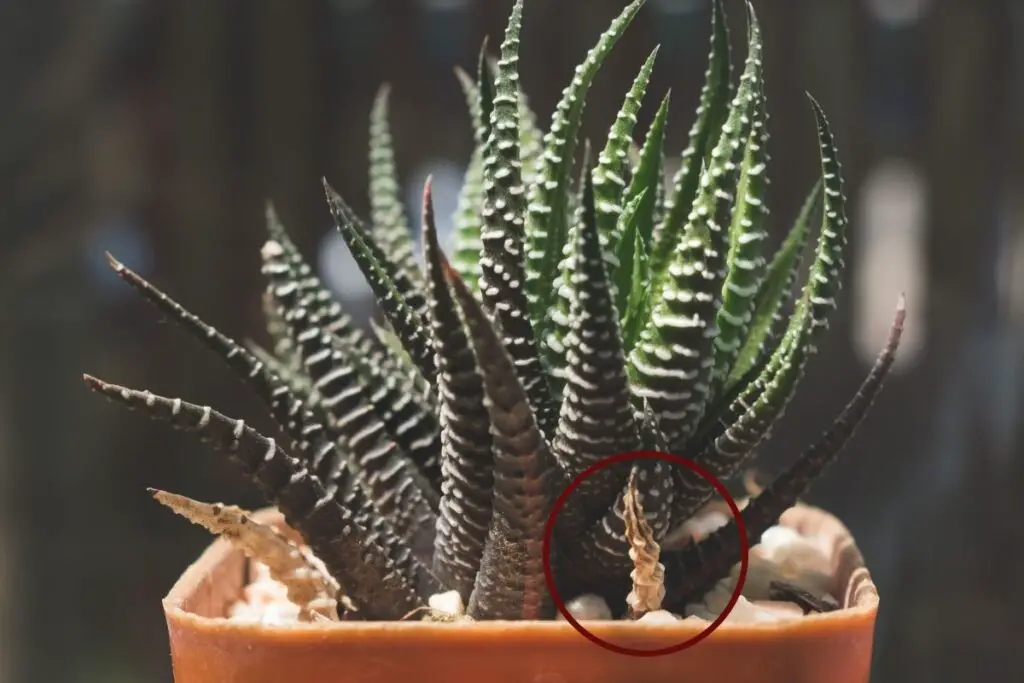
This happens mostly due to underwatering.
Indeed Haworthias can stay without water for a long time, but the time limit is up to 2-3 weeks, not several months.
Eventually, they will need water to stay strong and hydrated.
Without water, they will turn dry and crispy.
The leaves will lose their thickness and fleshiness and become thin and crispy.
First, the lower leaves suffer because when you don’t provide water, the upper leaves start absorbing water from the bottom leaves and turn brown or crispy.
Over time, all the leaves of Haworthia will go brown and crispy.
This can also happen during rootbound situations.
When they get root bound, the roots are seen more than the soil.
When you give them water, it roams about around the roots and immediately comes out of the drainage hole.
Without soil, the plant cannot absorb water, and thus they suffer underwatering.
How to solve the problem?
Solving underwatering is very easy than overwatering.
Give the plant a good drink.
For grounded Haworthias, soak the soil very well.
Provide water until the excess water drains out of the drainage holes for potted plants.
Always repot Haworthias when they outgrow their pots.
Repotting frequency should be once every 2-3 years.
Since they are slow-growers, they don’t require frequent repotting.
Also read: Why Is My Haworthia Turning Brown? (Causes+How To Fix)
Looking for gardening supplies? We have tested 100's of products before recommending them to you guys. Check out our best pick below:
| Image | Gardening Supplies | Best Price? |
|---|---|---|
 Top
Top Top
Top | Raised Garden Bed Kit | Check On Amazon |
 | XLUX Soil Moisture Meter, Plant Water Monitor, Soil Hygrometer Sensor for Gardening, Farming, Indoor and Outdoor Plants, No Batteries Required | No Results |
 Top
Top Top
Top | 82 Pcs Garden Tools Set and Extra Succulent Tools Set | Check On Amazon |
 | Joeys Garden Expandable Garden Hose with 8 Function Hose Nozzle, Lightweight Anti-Kink Flexible Garden Hoses, Extra Strength Fabric with Double Latex Core, (50 FT, Black) | No Results |
 Top
Top Top
Top | Dual Chamber Compost Tumbler | Check On Amazon |
 Top
Top Top
Top | Sunnyglade Plant Stakes | Check On Amazon |
 Top
Top Top
Top | Organic Cold Pressed Neem Seed Oil | Check On Amazon |
 Top
Top Top
Top | Mighty Mint Gallon :-Insect and Pest Control Peppermint Oil | Check On Amazon |
 Top
Top Top
Top | Scotts DiseaseEx Lawn Fungicide | Check On Amazon |
 Top
Top Top
Top | Jacks Classic 20-20-20 All Purpose Fertilizer | Check On Amazon |
 Top
Top Top
Top | 30,000 Seeds Pollinator Attracting Wildflower Mixture | Check On Amazon |
 Top
Top Top
Top | Survival Vegetable Seeds Garden Kit-Over 16,000 Seeds | Check On Amazon |
Leaves turning yellow
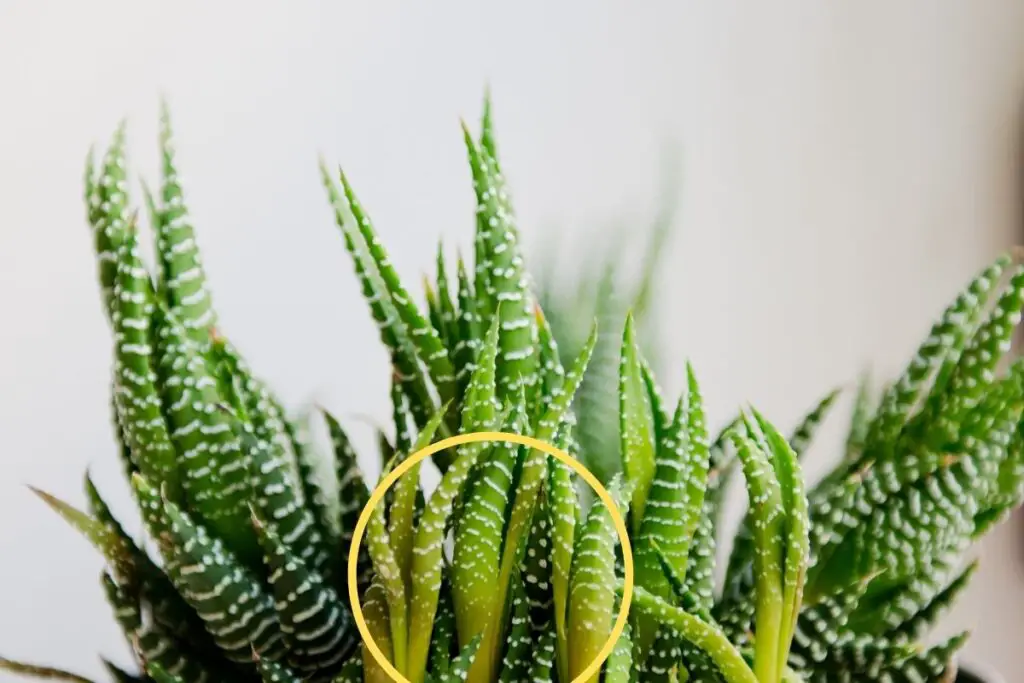
Yellow, soft, and mushy leaves are a problem of watering or drainage, which we have already discussed in the earlier points.
Here, we will talk about other reasons which can also make Haworthias yellow.
Haworthias may turn yellow due to low light or exposure to sunlight.
Haworthias will grow under indirect sunlight.
Some people try to save the plant from the direct sun and shift them to a very dim or shady area.
This further results in yellowing of the leaves because they suffer from chlorosis due to low light conditions.
Mostly the patterned leaves suffer the most.
This will also make the plant escalate.
Haworthias cannot tolerate direct sun because they grow under shrubs or grasses in their natural habitat.
Exposure to direct sun can turn them yellow, red, or white.
It is a natural pigment produced by the plant to protect them from the direct sun.
Another reason could be pest infestation.
As the pests suck out all the juices from the plant, the leaves turn yellow, pale, and weak due to dehydration.
It also makes them susceptible to various diseases.
What should I do to prevent it?
Fixing the light problems is easy.
Select a place that receives bright indirect sunlight.
If not, arrange and fix on shading nets or clothes.
Fix transparent shades to filter the light and not a thick one to block the light.
You can remove the shade for 3-5 hours in the morning.
After that, when the sunlight gets intense, put the shade back to filter the sun.
This will not only save them from light issues but will also keep them healthy.
To fight pest infestation, you can use both organic and inorganic materials:
- Spray Neem oil or soapy water.
- Apply insecticidal soaps like Castile soap or Safer soap.
- Dab rubbing alcohol on the infected areas to weaken and kill them.
- You can release ladybugs to let them feed on soft-bodied scales and aphids.
- The above materials must work. The last option is chemical pesticides, insecticides, and miticides.
Also read: Why Is My Haworthia Turning Yellow? (Causes+How To Fix)
Leaves browning at tips, bottom and brown spots all over
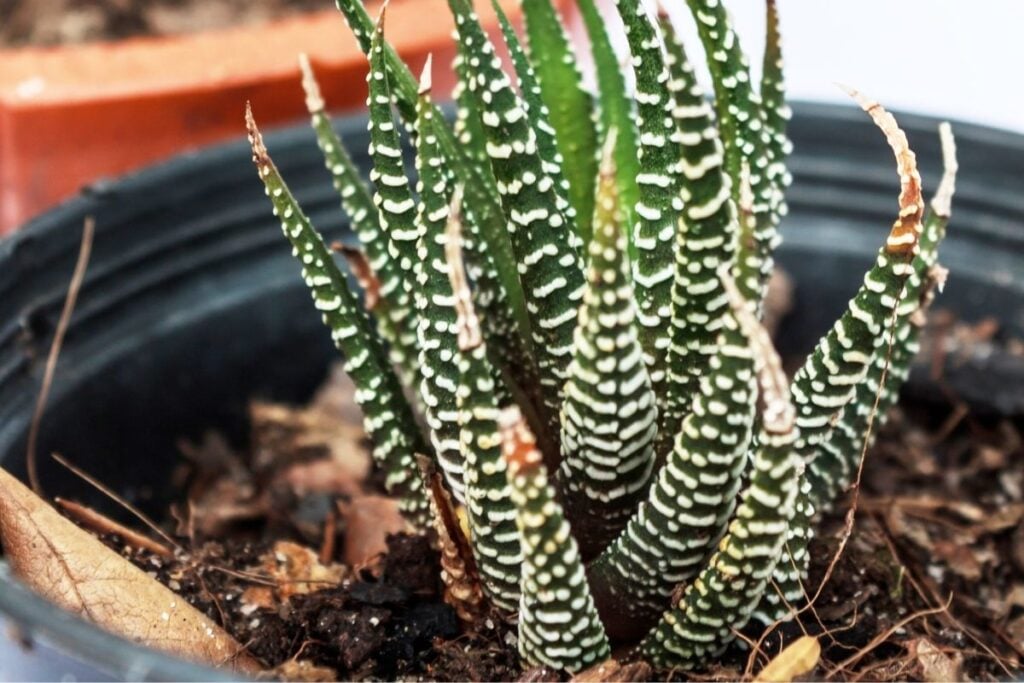
There are lots of reasons behind Haworthia turning brown.
We have already spoken of overwatering, underwatering and poor drainage.
The bottoms leaves turn brown first.
Other reasons include sun exposure, edema (overwatering result), nutrition deficiency, over-fertilization, air currents, infestation, and natural aging.
Out of all, aging is natural.
The old ones will fall off and grow new leaves.
You can either let them fall off on their own or remove them beforehand if you don’t like the look.
For other reasons, you need to solve them quickly.
Else your Haworthia is going to end up dying.
Not all reasons will kill your plant.
For example, edema and air currents will not kill the plant.
But they will make the plant weak.
To treat edema, stop watering for some weeks.
Nutrient deficiency too won’t kill the plant because Haworthias are not heavy feeders.
But, in some cases, when the soil cannot provide all the nutrients, fertilization boosts its growth and provides them with all its required nutrients.
What should be done?
Bright indirect sunlight best suits them as they grow under shrubs and grasses in their natural habitat.
Direct sunlight can burn them and make the leaves brown at the tips and edges.
Ensure to protect them with shading clothes when the sunlight increases its intensity.
For indoor plants, use sheer curtains or try the north or east-facing windows.
To solve nutrient deficiency, fertilize them lightly with a balanced fertilizer or the one having an NPK value of 3:1:2.
Do it only in the spring and fall once. Not more and not on any other season.
Timely repotting can also rejuvenate the soil and refill it with new nutrients, thus preventing under fertilization.
If you are unsure about the right frequency and amount, avoid it.
You can use soil mix combined with fertilizers.
If you feed them the wrong way, the salt level of the chemical will be more than that of the soil.
It causes reverse osmosis and turns the leaves brown due to salt burn.
Planting Haworthias in open space gives them air currents during strong winds.
This results in faster moisture loss, thus brown leaves.
Make sure there are some trees or buildings around to block the strong winds.
But these blockages should not be too much.
Else they can block the entire sunlight.
Pests like spider mites, mealybugs, aphids, scales, or snails sucking sap too can result in browning.
First, they turn yellow and then brown when the problem stays long.
In worst cases, the leaves will deform and fall off.
I have already mentioned the ways and materials to remove them in the previous point.
Try to avoid prolonged dampness or dry conditions in the plant to prevent pests.
Some fungal diseases like southern blight, rust, botrytis blight, and powdery mildew can also cause browning.
Isolate the plant and use some fungicide to treat the problem.
When you watch the signs, the disease is already there.
It is better to prevent the disease or become hard enough to fix.
Leaves turning white or red
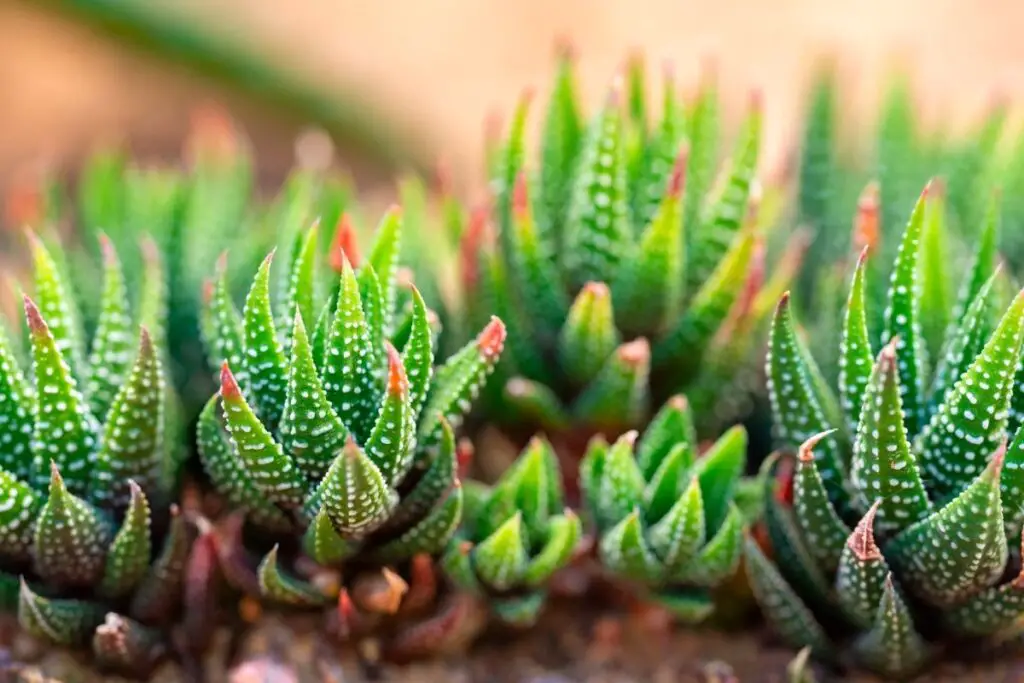
Sun exposure and temperature stress are the main culprits.
However, the good news is this will not kill your plant.
The leaves turn white, red, or yellow because they produce a pigment called anthocyanin, due to which the leaves get discolored.
This pigment tries to protect the plant from sunburns and temperature shock.
You can call it a signal of threat right before the damage.
Either your plant is under direct sunlight, or they are exposed to extreme temperatures.
You must catch the signal to protect the plant from such conditions.
Other reasons are watering, drainage, pests, and fungus issues which I have already explained before.
What to do here?
For solving sun exposure, I have already explained in the earlier points.
You cannot do anything if your Haworthias are outdoors to protect you from sudden temperatures.
They will adjust themselves by adapting to the outdoor climate.
However, you can keep them cool in summers by watering them when the soil gets too dry.
If your region gets temperature below 30°F, plant them in pots so that you can take them indoors in the cold temperatures.
Indoors, don’t keep the plant close to air conditioners, heaters, or radiators.
Bring them a few feet back from the open window during strong winds.
Sometimes, white spots could be due to powdery mildew, a fungus issue.
The leaves will have white marks resembling talcum powder.
The red marks on the leaves and stems could be due to spider mites.
Solutions are elaborated in the earlier points.
Also read:
- Why Is My Haworthia Turning White? (Possible Problem+Solution)
- Why Is My Haworthia Turning Red? (Causes+How To Fix)
Leaves falling off
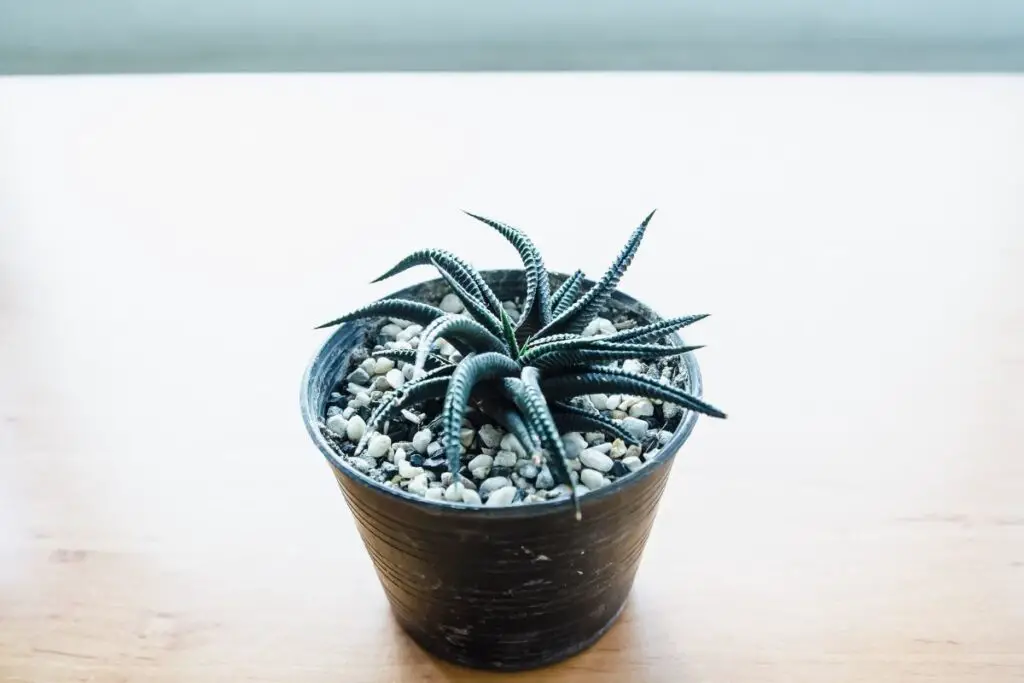
The reasons for the improper light, water, drainage, temperature, and chemical shock again.
Improper watering for prolonged periods will make the leaves so weak that they fall apart even with a light touch.
Inadequate light will also make the soil dry for a long time and result in prolonged sogginess, thus overwatering.
Due to this, the leaves will again fall off if touched. The same is with poor drainage as water fails to drain out from the soil or container, thus causing prolonged dampness.
Overfeeding gives the plant chemical shock, burns the roots, makes the plant weak, and results in falling leaves.
Another situation when the plant receives chemical shock is using too many pesticides or miticides.
Due to this, they will start losing leaves.
Follow the same instructions for light, water, drainage, temperature, and fertilizer as the previous points.
To avoid chemical burn, read the instructions given in the product labels carefully and then use as recommended.
Also read: Why Is My Haworthia Falling Apart? (Possible Causes+Solution)
Plant not growing
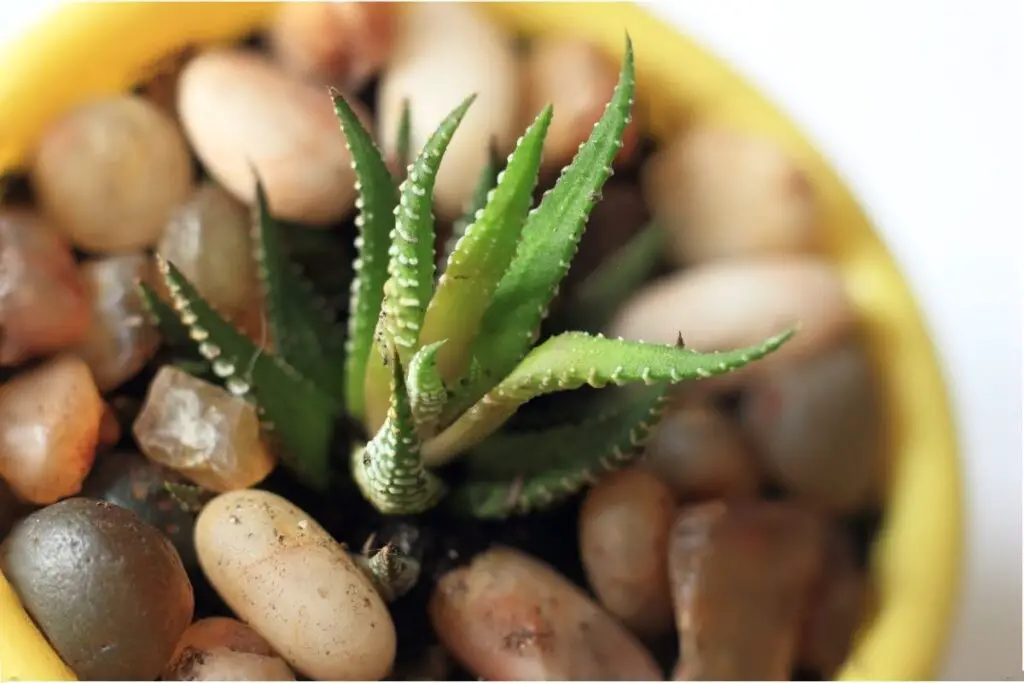
The same reasons apply here too.
Lack of light, watering issues, temperature issues, drainage issues, pest and fungus infestations, and nutrient deficiency.
These problems can interrupt the plant’s development and stop them from growing.
Without adequate light, the plant won’t photosynthesize properly and stop growing.
Exposing the plant to too hot or cold temperature can force them to become dormant and thus stop its growth.
However, summer dormancy is Haworthia’s natural dormancy period, and there is nothing to do.
Rootbound and overcrowding can also lead to no growth because many roots and offsets stay tight inside a small pot and fight for nutrients and space.
When water and nutrients are not enough, they stop their growth.
However, these don’t kill your plant.
If you identify the problems and take action beforehand, you can save your plant.
Also read: Why Is My Haworthia Not Growing? (Possible Problem+Fix)
Leaves get distorted
Pests like aphids, spider mites, scales, and snails, animals like cats, dogs, rabbits, horses, and others like to feed on the leaves and make them distorted and out of shape.
The critters feed on the leaves to suck out the saps from the plants, due to which you will find lots of holes in them.
The other animals would love to munch the leaves to satisfy their appetite or curiosity.
The plant will be out of shape, and the animals’ bites will destroy them and kill them.
To get rid of pests, we have already discussed them before.
To get rid of the other animals:
- Create a physical barrier or fence around the garden bed.
- Keep it out of the pets’ reach. Plant them at such a spot where pets don’t loiter much.
- You can use deterrent sprays like Plantskydd or Liquid fence
- You can plant companions like Sage, Lavender, or Marigold. They hold a strong smell hated by the animals.
- You can spray cayenne powder, mothballs, and methyl nonyl ketone crystals around the garden.
Leaves with damp black spots
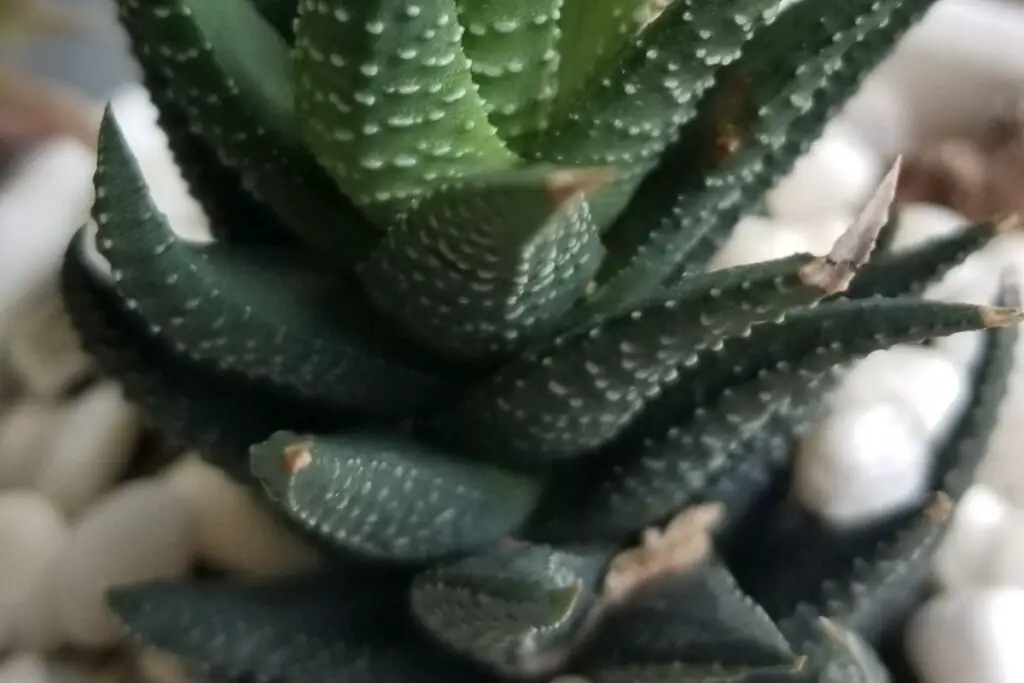
These are seen when the plant experiences diseases or cold injury.
Being tender succulents, Haworthia cannot tolerate excessive cold weather.
When the temperature drops below 30°F, you must take the plant indoors.
Otherwise, it will have frostbite, which looks like damp black spots.
The tissues and cells of the plant burst inside due to frozen weather and display such marks.
Once the frostbite spreads into the stems, the plant will die.
How to fix it?
You must take precautions. It is the best way out.
To revive the plant from such conditions, keep them indoors at a place where there is no cold.
Don’t bother them with watering, direct sun, or fertilizer.
Remove the damaged leaves and let them dry.
Within some weeks, they will be fine.
If your region receives temperatures below 30°F in winter, plant Haworthia in containers so that you can take them inside in cold weather.
But if your region belongs to zones 9-11, you can grow Haworthia indoors. Water sparingly to keep them hydrated and don’t fertilize.
Key needs
Let’s look at some key needs of Haworthia plants.
| Factor | Key Needs |
|---|---|
| Water | Water only when the soil feels dry. It is the best way to understand watering needs. Never deprive them of water for months. Be careful while watering during the summers and winters. They absorb water slowly. |
| Light | Keep them under bright indirect light. |
| Soil | Plant them in well-drained soil. |
| Pot | Make sure the container has drainage holes. Empty the saucer always. Use terracotta pots for good results. |
| Temperature | Don’t expose them to too cold or hot temperatures. Bring them indoors if needed in winters. |
| Fertilizer | Fertilize only during the spring and fall. Avoid during summers and winters. |
| Pests | Look out for pests and check your plant’s condition daily. |
| Repotting | Repot every 2-3 years |
Final words
Any problem that you neglect for too long leads to a dying Haworthia. But you can always bring the plant back to health with proper maintenance.
You must look at the signs carefully, identify the problems behind them and treat them as required. One sign could be a reason for one cause or multiple causes. So, identify well while diagnosing.
Reference: The Haworthia Society, Botanical Studies, University of Wisconsin-Madison, Sciencedirect, Researchgate, Haworthia Study.
